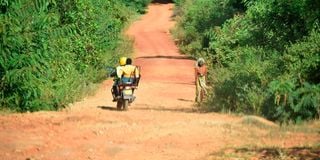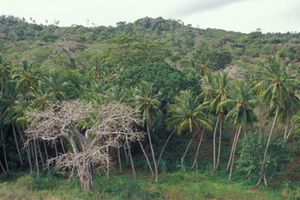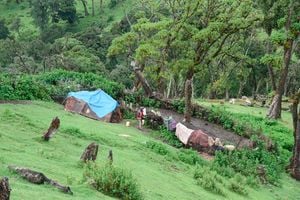
A section of the Shimba Hills National Reserve in Kwale County on Ferbruary 27, 2024.
As you traverse the Kinango-Samburu road off the Nairobi-Mombasa Highway in Kwale County, you’re met with a stark contrast.
What was once a lush, vibrant forest, now stands as a stretch of almost 50 kilometres of small shrubs and open green fields.
This evident contradiction paints a vivid picture of the destruction of a once luscious jungle. Back in the 1970s and 1980s, and even recently in the 1990s, this area had a thriving ecosystem, dominated by indigenous trees. Today, it’s a mere shadow of its former self.
For now, at least, the landscape is leafy and green, thanks to recent rainfall — a marked difference from just a few months ago. Back then, drought had taken a toll on this area, leaving little but parched vegetation and dust swirling in the air.
The dwindling forest cover in this part of Kenya has largely been attributed to the persistent practice of charcoal burning. Despite numerous efforts to raise awareness about the importance of environmental conservation, this destructive economic activity continued to thrive.
According to Omar Weko, the founder of Kenyans For Green World, a conservation community-based organization in the area, Kwale remains one of the leading producers of charcoal among the coastal counties of East Africa’s largest economy.
However, while individuals continue to clear swathes of forest cover to produce charcoal, which supplies energy to almost 100 per cent of the people in this area, an even more alarming form of destruction is unfolding in another part of the county.
In August last year, Kwale County Forest Conservator Blessington Maghanga raised an alarm over the increasing destruction of indigenous trees in the region, extending beyond the Shimba Hills. He revealed that two tree species – the Afzelia Quanzensis, locally known as Mbambakofi and Milicia excelsa or the African teak, which is known here as Mvule - were teetering on the brink of extinction in the county.
According to Maghanga, who echoes the concerns of conservationists regarding the increasing threat of extinction to the region's biodiversity, the destruction extends beyond adjacent areas, including private farms where such trees were traditionally growing in abundance, to the gazetted forest.
“Initially, the two tree species were somehow dominant in their canopy covers even within the farmlands, but right now, if you see, the canopy, is actually being decimated,” he explains.
Data from Global Forest Watch, an online forest monitoring and alert system, indicates that from 2002 to 2023, Kenya lost 52.5 kha of humid primary forest, making up 14 per cent of its total tree cover loss in the same period. Additionally, this data shows that Kwale County was among the top 6 regions that were responsible for 52 per cent of all tree cover loss between 2001 and 2023.
A 2018-2019 Kenya Water Towers Status Report for Shimba Hills linked degradation to illegal logging. The report further indicated that commercial exploitation of targeted species including the Milicia excels (African teak) and Afzelia quanzensis, was driven by ready market for timber.

A section of the Shimba Hills National Reserve in Kwale County on Ferbruary 27, 2024.
The International Union for Conservation of Nature lists all species of Afzelia as threatened trees, and here in Kenya, the Afzelia quanzensis (Mbambakofi) is listed among species on the Red List under 'Near Threatened'.
On the other hand, the the Milicia excels (African teak) or Mvule is considered threatened, and according to WWF, levels of exploitation have been unsustainable in all countries and the species' habitat has declined to an alarming degree.
The main problem today, according to Maghanga, is illegal logging and insufficient enforcement to ensure compliance with CITES regulations.
The primary driver of this relentless forest cover loss is the high value placed on the trees for their timber.
“One mvule tree can get you up to Sh150,000 ($1,159) worth of timber. One foot goes for between Sh350 ($2.7) and Sh400 ($3), for a tree that can take between 80 and 100 years to grow to a merchantable value,” adds Maghanga.
Such value, together with a ready market, is a recipe for destruction for this tree especially here in an area which according to the Kenya National Bureau of Statistics, has a poverty index of 41.8 per cent, compared to a national average of 12.2 per cent.
The ready market is mostly from Asian countries, and this has put pressure on timber exporters in the country, who are attracted to the trees because of their durability, resistance to pests, and attractive grain patterns, which make them highly sought after for luxury furniture and flooring.
Last year, Dr Joshua Cheboiwo, Director of the Kenya Forestry Research Institute (Kefri), raised concerns about the transboundary timber trade in Africa.
He highlighted issues such as informal operators dominating the trade without proper licenses, illegal activities like under-declaration of quantities at borders, utilisation of unregulated border points, and the use of falsified documentation.
These factors have led to significant losses in both forest resources and revenue. Specifically, the illegal timber trade between Kenya and Tanzania has resulted in the depletion of 70,000 hectares of forests and a loss of $10 million in revenue.
Maghanga blames local residents for the illegal business.
“After clearing the nearby trees in their homesteads and farms for wood and timber, locals have begun salivating for the indigenous trees in public forests,” he adds.
And he has evidence to back his claims. Over the years, Maghanga says, the KFS officers in Kwale have made numerous arrests. Our efforts to get the exact data from KFS on arrests made so far were futile.
But even as Maghanga blames the locals for this destruction within their farms, and now the forest, there are skeptics who believe that the small timber cutters within the area are just a mask for a bigger syndicate.
Rama Nassoro Yabo, Chairperson of Ushirikiano Welfare Group, a local association of timber cutters, explains that felling trees on private farms isn’t a clear-cut process.
“For instance, even for the planted trees, the approval process has to involve an agricultural officer, the chairman of the village, the chief, the ward administrator and eventually the KFS, before one is allowed to cut the tree.”
On the other hand, he says, it is almost impossible to get a permit to cut an indigenous tree.
“This is unless you have a very pressing emergency. Maybe someone has a child that has been sent away from school due to lack of school fees, or perhaps, in the case of a medical emergency where the owner needs money for medication,” explains Yabo.
But even with this, Yabo explains, the request from the owner of the indigenous tree has to be backed up with proof such as a school fees structure, or photos of the ailing person.
In July 2023, President William Ruto ended a six-year ban on logging in public and community forests. Prior to the imposition of this logging moratorium in 2018, a task force mandated to assess forest resource management in Kenya and logging practices had uncovered widespread misconduct within the Kenya Forest Service Board and Management.
This included allegations of office abuse, corruption, unethical conduct, and a lack of transparency.
The repercussions of these malpractices included the illegal and unregulated logging of indigenous tree species, unauthorized settlements, and extensive development of public infrastructure, which blurred the distinction between conserving forests and exploiting them.
But even with this, according to Maghanga, KFS is currently enforcing a presidential moratorium, where no one is allowed to cut down indigenous trees even within their farms.
It is not clear how effective this moratorium is, considering that last year President William Ruto lifted a ban on logging.
But one person who seems to understands just how tough things could get is Hassan Salim Tsunusi, a carpenter from Vidziani village, in Kwale. On January 31, 2024, this 35-year-old father of six had cut a mvule tree on his farm after allegedly verbally communicating his intentions to a local Kenya Forest Service (KFS) officer.
“I had just gotten a tender to supply 15 box beds to a local businessperson, after receiving a Sh40,000 ($311.28) down payment. After delivering the order, I had planned to use part of the payment from my client to pay school fees for my sister, who was about to join high school,” he adds.
But that was not to be. On February 9, 2024, officers from KFS’ Kwale office conducted a surprise raid on his workshop and seized up to 40 pieces of mvule timber.
Presently, in addition to grappling with the uncertainty of providing for his family’s basic needs, Tsunutsi remains haunted by concerns for his safety because he hasn’t yet completed the tender, and his client is getting ever more impatient.
But other than the locals cutting down trees within their farms, our investigations reveal just how hard it is for a normal citizen to get into the forest and cut just any tree let alone an indigenous one.
A vice chair of a community forest association within Shimba Hills community who requested to remain anonymous, remembers that night she received a distress call from someone who lives in Mbokweni, which is the other part of the forest.
“I live in Mawia within the five-kilometre buffer zone, and by the time we reached there, 30 trees had been felled. You think small locals can pull that off?” she asks.
According to her, the perpetrators are not local and they have changed tactics.
“In order to successfully pull off their illegal acts within the forest, first of all they do not use machine saws but instead use hand saws,” she adds.
Apart from being noisy, she says, the power saw has chains which leave visible marks on the wood, affecting the quality of the timber, and, eventually, its price.
Again, she reveals that these criminals also no longer use huge trucks.
“Instead, they stuff the logs in Toyota Probox vehicles. With the Probox vehicles, it is not easy to suspect because here, they are also used for public transport. Also, they are small vehicles, and so they can easily manoeuvre through the narrow pathways within the forest, unlike the huge tracks.”
According to Yabo, the indigenous trees are found inside the forest.
“Outside the forest getting a mbabakofi that you can extract 20 pieces of timber from is almost impossible. We live close to the forest, but we cannot cut trees from within, and more so the indigenous trees, because the forest is a protected area,” he explains.
But the irony is even with these restrictions, still the number of indigenous trees within the forest has continued to dwindle.
In the meantime, along Kwale-Lungalunga road, which is just a few kilometers to the Shimba Hills conservancy, there are numerous timber workshops. Others admit they have mvule, but they say they get their timber softwood from Tanzania, and hardwood from DRC.

Rama Nassoro Yabo, the chairperson of Ushirikiano Welfare Group, a local association of timber cutters in Kwale County.
“Our furniture is high end where a bed can go for as high as almost Sh300,000 ($2300). Our products are expensive because of the quality of timber we use. We normally use timber from mvule, but ours mostly comes from DRC, which is different from the one that comes from Kenya,” explains a worker at a high-end furniture workshop in Kwale.
Maghanga confirms this. “The softwood from Tanzania is usually from cypress and pinus trees. On the other hand, the mvule tree timber imported by businesspeople, comes from the equatorial forest within DRC,” he adds.
However, according to Dr Willis Okumu, a researcher at the Institute for Security Studies Nairobi, Enhancing Africa’s Response to Transnational Organised Crime (ENACT), Mvule is listed among endangered species meaning that its trade anywhere is illegal.
“Anybody claiming in trading because it is coming from a different country is committing a crime in itself, because it is illegal to trade in any endangered species,” he adds.
Another irony is the dwindling number of indigenous trees in the areas that some of these workshops operate. Global Forest Watch data indicates that from 2001 to 2023, Kwale lost 20.2 kha of tree cover, and there were 2,494 deforestation alerts reported in Kwale between 23rd of December 2022 and 24th of June 2024, covering a total of 31 ha.
Maghanga says the KFS faces challenges in the enforcement of tough laws against illegal logging.
“There are laws, for instance, the Forest Conservation and Management Act No 34 of 2016, which aims not just at trees within the public land, but even in private land.”
However, he says, there are limitations when it comes to the consent of the landowner. “Perhaps, a landowner is cutting down trees on his land, and sometimes it becomes a problem to take them to court.”
In short, he explains, under the present Forest Governance Act, issues to do with farm forest have been devolved.
“The County Government has a Forest Act, but again the act is not coming out clearly on enforcing tree cutting within the private farms. And that’s where the locals get the loopholes to cut the trees.”
The KFS, Maghanga says, is mandated by the law that anyone with the rank of sergeant and above, is allowed to get into any timber yard to demand for a timber selling permit.
But nonetheless, he admits there is a serious problem. “We have made numerous arrests of people penetrating the forest illegally for the purpose of logging. Unfortunately, he says, on the other hand, the law is weak.
In one instance, two suspects, Hamisi Mzungu Rocha and Bakari Juma Mwatsenze, were apprehended in the Kirewe area of Shimba Hills Nature Reserve on December 29, 2022, for illegally cutting down and logging three Alfzelia quanzensis (Mbambakofi) trees.
They pleaded guilty on December 30, 2022, and were subsequently charged on January 12, 2023.

A carpenter in his workshop using pieces of the indigenous Mvule tree in Lukore area of Shimba Hills in Kwale County on February 27, 2024.
Each faced two charges: (1) illegal felling of trees in a gazetted forest and (2) possession of logging tools in a gazetted forest. They were fined Sh30,000 ($233.46) for each count, totaling Sh60,000 ($466.93). Failure to pay the fine would result in a five-month jail term for both charges combined.
According to Maghanga, compared to the current Forest Act 2016, the initial Forest Law, 2005, was merciless for people destroying forests. “It ensured that a person arrested is sentenced to a year in prison, or pays a fine of an amount not less than Sh50,000 ($389.11).”
“Then our legislators went to the parliament and diluted it. Now, the law says that someone found guilty (of felling trees) is to be fined an amount not exceeding 50,000, or to serve a sentence not exceeding one year.”
“Currently, individuals can face mere fines of Sh2,000 ($15.56) for the destruction of a tree that may have taken up to 50 years to grow. In some cases, offenders receive only a two-week sentence upon court conviction, while in more severe instances, they may be subjected to non-custodial home sentences,” says Maghanga.
And with this, he says, sometimes they get discouraged comparing the effort they have taken to arrest the criminals and the lenient sentence they get in court.
“This kills the motivation of officers and even the foresters, eventually impacting negatively on the conservation efforts.”
According to experts, this is one of the primary challenges that will persistently affect conservation efforts, not only within the Shimba Hills conservancy but also in other forests across the country.
This story was produced with the support of Internews' Earth Journalism Network. [email protected]







